
views
X
Research source
Of those, over 800,000 people are hospitalized due to fall-related injuries. At some point, everyone slips or falls. You do not want to get hurt, or see someone hurt, because of these accidents. If you do take a tumble, learn how to protect yourself and fall as safely as possible.
Landing Safely

Roll to safety. When you are falling, you can reduce the chance of injury by tucking yourself into a ball and rolling. Not only will this tuck in your fragile body parts, but it will also reduce the impact your body will take when it hits the ground. There are various techniques to rolling successfully. For a gymnastic roll, you want to place your hands in front of your body and tuck your chin down. Use your falling momentum to roll. You want to make sure you keep your body symmetrical as to avoid injury. This type of roll, when done correctly, may even carry you into a standing position. A second type of roll is a parkour or asymmetric roll. The trick to this roll is to try and take the brunt of your fall with your shoulder before you begin the roll. Your goal is roll along your back in a diagonal fashion. This type of roll is preferable by martial arts and parkour experts as it protects your hands and vertebra.

Avoid dangerous objects. If you are falling and you see dangerous items like broken glass or sharp objects, try and propel yourself away as you fall by pushing yourself or rolling. If you can not avoid these dangerous objects, protect your face by covering it with your arms.

Practice falling in a safe environment to become an expert in types of rolling. You can visit a gym or a martial arts studio to practice falling on soft mats and padded floors. Just like anything in life, falling without hurting yourself will take practice! Minimize damage to yourself by practicing in a safe environment first.

Look down and assess the situation. If you are falling straight down, called a vertical fall, it is best if you look below and calculate your landing. You can look for a safer place to fall, or warn people if they are below you. There are also a number of techniques parachutists use in vertical falls to aid in safer landings. Land on the ball of your feet and twist your body away from the direction of momentum. Try and press your knees together. Once you hit the ground, bend and twist so that your calf and your thigh muscles will hit the ground before your head and shoulders. Ensure that your head remains as tucked into your chest as tightly as possible. You want to avoid head and neck injuries at all cost.

Relax. Humans have an innate fear of falling. However, it is best if you try and relax your limbs, especially your legs, when you fall. Tensing your muscles can cause more of an impact, increase resistance and torsion and therefore, cause more injuries. If you are falling backward, attempt to bend your knees and curve your back. This will help you relax before impact, minimizing jarring movements. If you are falling to the side, curve upward to avoid slamming your head into the ground. Keep your body relaxed and breathe to avoid tensing muscles before impact.
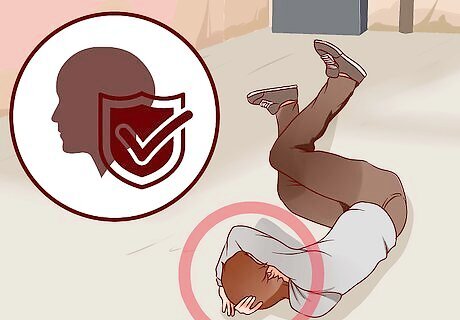
Protect your face and head when falling. Never try to break your fall! To protect your head from impact, keep your chin up and protect yourself with your arms. A common source of injury during falls is a laceration on the tongue from biting into it. Throughout the fall, try to keep your tongue planted on the floor of your mouth, tucked up behind your lower teeth, so that the impact does not cause your jaws to close on it and injure it.

Fall into a triangle pose. To avoid smashing your face or groin into the ground, try a triangle pose. This is a front fall designed by police officers. You want to maximise the surface area when you hit the ground by falling with your hands above your head in a triangle shape. Place your feet equi-distant apart and try and land on your toes (kind of like a push up position).
Avoiding or Assessing Fall-related Injuries
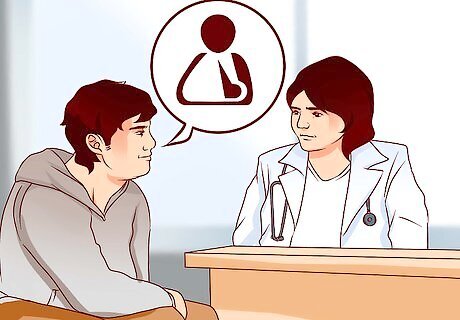
Assess your bones. A common injury in falls is broken bones. Broken hips and arms are especially common in the elderly. You may experience pain or swelling. You may hear grinding, snapping, or creaking. If you think you have broken a bone due to a fall, call EMS and contact your doctor immediately.
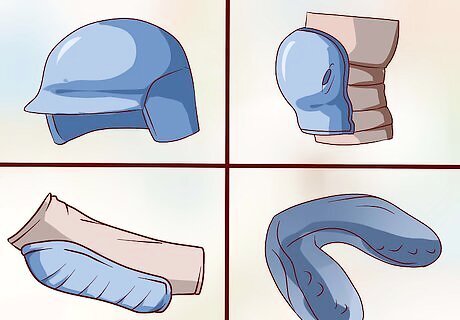
Wear protective equipment. If you are doing something that has a high risk of falling (biking, hiking, construction, manual labor, etc) make sure you wear the proper protective equipment to help minimize risk of injury. These may include helmets, knee pads, elbow pads, and mouthguards.
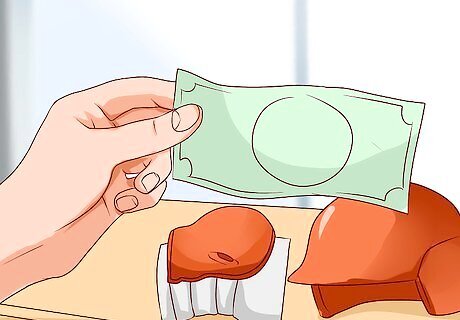
Buy the right safety equipment. You can hurt yourself if you wear ill-fitting equipment or use the equipment incorrectly. Know how and what to buy — and how to wear it — when doing a particular task like renovation or construction work.
Method 1 - Avoiding Dangerous Places

Watch the weather report. If you do not have to be out inclement weather, try your best to avoid it. If you live in a climate when you get ice and snow, tune in daily or hourly to get an updated look at conditions. This will help you dress properly and minimize fall risk.

Plan the best route. Does your morning commute include walking up a steep hill? If it does, you might want to find an alternative route if that hill is prone to getting slippery in the rain or snow. Practice driving or walking various routes to find the safest conditions.

Be aware of your surroundings. People can sometimes have a lot on their minds and may not be paying attention to their surroundings. Avoid falling by looking out for uneven ground, broken terrain, curbs, and other hazards.

Wear the proper gear. Make sure you aware appropriate clothing and footwear in order to ensure that you do not accidentally fall. This may include rain boots for wet conditions, or sturdy footwear. Women should avoid wearing high heels if walking in soft terrain.

Look for established paths and safety items. Look for safety rails and ramps to assist you in walking or climbing. Be aware of signs that state warnings of dangerous areas or terrain.
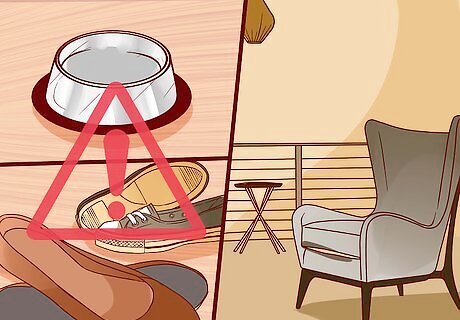
Keep your environment clear of hazards. You can face falling hazards in your home. You may trip over a pet or an item that is out place. Make sure that items such as pet bowls and shoes are put away to avoid accidental falling. Establish a house cleaning routine to keep your living space free of clutter.




















Comments
0 comment